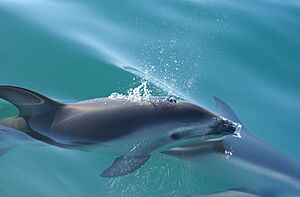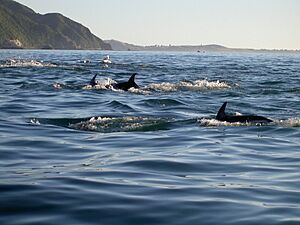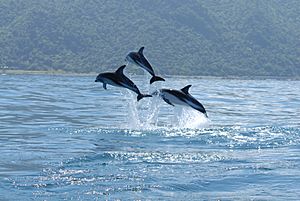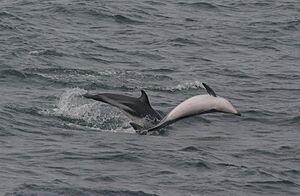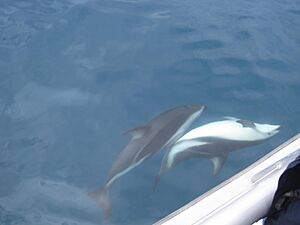Dusky dolphin facts for kids
Quick facts for kids Dusky dolphin |
|
|---|---|
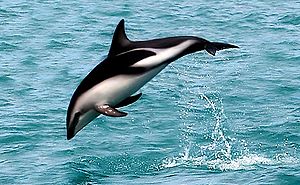 |
|
 |
|
| Size compared to an average human | |
| Conservation status | |
| Scientific classification | |
| Genus: |
Lagenorhynchus
|
| Species: |
obscurus
|
| Subspecies | |
|
|
 |
|
| Dusky dolphin range | |
The dusky dolphin (Lagenorhynchus obscurus) is a type of dolphin. It lives in coastal waters in the Southern Hemisphere. Its scientific name, obscurus, means "dark" or "dim" in Latin. This dolphin is very closely related to the Pacific white-sided dolphin. However, scientists agree they are different species.
Dusky dolphins are found in different areas. Major groups live around South America, southwestern Africa, and New Zealand. They are also seen near some oceanic islands. Sometimes, they are spotted around southern Australia and Tasmania. Dusky dolphins like cool ocean currents and waters close to shore. But they can also be found further out at sea. They eat many kinds of fish and squid. They can also change how they hunt. The dusky dolphin is famous for its amazing jumps and tricks in the air. We do not know the exact number of dusky dolphins. However, they are often caught by accident in fishing nets called gill nets.
Contents
Discovering the Dusky Dolphin
Many people believe that John Edward Gray first described the dusky dolphin in 1828. He studied a stuffed skin and a skull. These were sent to the British Museum from the Cape of Good Hope. Gray first called the species Delphinus obscurus.
However, Gray later learned that French scientists had described a similar dolphin earlier. René Primevère Lesson and Prosper Garnot found a specimen near Tasmania. This was two years before Gray's discovery. Gray then said their description was the first. Later, Charles Darwin also described this species in 1838. He called it Delphinus fitzroyi. This was from a dolphin caught off Argentina. The dusky dolphin got its current scientific name, Lagenorhynchus obscurus, in 1889. This name was given by American biologist Frederick W. True.
Dusky Dolphin Family Tree
The dusky dolphin and the Pacific white-sided dolphin are related by their genes. Some researchers thought they might be the same species. But their body shapes and life stories show they are different. These two species separated about 1.9 to 3 million years ago.
Scientists have found that the group of dolphins called Lagenorhynchus might not be a natural group. This means some dolphins in this group might be more closely related to other types of dolphins. One study suggests that the dusky dolphin and Pacific white-sided dolphin are closely related to the Cephalorhynchus genus. If this is true, they might need a new genus name.
Dusky dolphins from Argentina and southwest Africa became separate groups a long time ago. They have not mixed much since then. Most groups of dusky dolphins have low genetic diversity. This means their genes are very similar. The dolphins in Peru are an exception, with more genetic variety. There are four known subspecies of dusky dolphins.
What Does a Dusky Dolphin Look Like?
The dusky dolphin is a small to medium-sized dolphin. Its size can vary a lot depending on where it lives. The largest dusky dolphins are found off Peru. They can be up to 210 cm (6 feet) long and weigh 100 kg (210 pounds). In New Zealand, females are usually 167–178 cm long and weigh 69–78 kg. Males are 165–175 cm long and weigh 70–85 kg.
It is hard to tell males and females apart just by looking at them. However, males have dorsal fins that are more curved. The back of the dolphin is dark grey or black. Its dorsal fin has two colors. The front edge is dark like its back. But the back edge is a much lighter greyish-white.
The dusky dolphin has a long, light-grey patch on its front side. This patch leads to a short, dark-grey beak. Its throat and belly are white. The beak and lower jaw are dark grey. Two white stripes run from the dorsal fin to the tail. Between these white areas, there is a dark, thorn-shaped patch. This unique mark helps people recognize the species.
Dusky dolphins can sometimes be confused with other dolphins in their group. But they are different from the common dolphin. Common dolphins have a longer beak and yellow markings on their sides. The skull of a dusky dolphin has a longer and narrower snout. This helps tell it apart from an hourglass dolphin or Peale's dolphin.
Where Do Dusky Dolphins Live?
Dusky dolphins live in many different places around the world. They are found off the coasts of South America, southwestern Africa, and New Zealand. They also live near southern Australia, Tasmania, and some oceanic islands.
In South America, they live from southern Peru down to Cape Horn. They are also found from southern Patagonia up to about 36°S on the east coast. Their home range also includes the Falkland Islands. They are very common near Peninsula Valdes in Argentina. However, they are not common in the Beagle Channel.
Dusky dolphins are found all over New Zealand waters. A large group lives between East Cape and Cape Palliser on the North Island. They are also common from Timaru to Oamaru on the South Island. They especially like the cold waters of the Southland and Canterbury currents.
In Africa, dusky dolphins live from Lobito Bay in Angola down to False Bay in South Africa. In Australia, they have been seen in colder waters near Kangaroo Island, eastern Tasmania, and Bass Strait. These dolphins might be visitors from New Zealand. They are also found near Campbell, Auckland, and Chatham Islands in the western South Pacific. Other locations include Tristan da Cunha in the South Atlantic, and Île Amsterdam and Île Saint-Paul in the southern Indian Ocean.
Dusky Dolphin Life and Habits

Dusky dolphins prefer cool waters where currents bring nutrients to the surface. They mostly live in waters close to shore. They can also be found further out, near the edge of the continental shelf. These dolphins can travel long distances, sometimes around 780 km. But they do not have clear seasonal migrations. However, dolphins off Argentina and New Zealand move closer to shore and further out at different times of the year and day.
In Argentina, dusky dolphins often swim near southern right whales and South American sea lions. They have been seen near bottlenose dolphins but do not seem to interact with them. They might share feeding areas with Risso's dolphins. They also hang out with many seabirds, like kelp gulls and albatrosses. In New Zealand, dusky dolphins mix with common dolphins. They have also been seen with southern right whale dolphins and pilot whales off southwestern Africa.
How Dusky Dolphins Communicate
Dolphins make three main types of sounds. These are click trains, burst pulses, and whistles. Click trains are many fast clicks. Burst pulses are very fast clicks that sound like a buzz to humans. Whistles are pure tones that change in pitch.
Dusky dolphins make all three sounds. But they most often make burst pulses. They whistle more when they are with other dolphin species, like common dolphins. They use echolocation to find things in the water. Their echolocation signals are short and cover a wide range of frequencies. These signals usually have two main peaks. One is between 40 and 50 kHz, and the other is between 80 and 110 kHz.
What Dusky Dolphins Eat and Who Eats Them
Dusky dolphins eat many kinds of fish and squid. Some common fish they eat include anchovies, lantern fish, pilchards, hakes, and red cod. They usually hunt together in a coordinated way. They can change their hunting methods depending on where they are.
In some parts of New Zealand, deep ocean waters meet the shore. Here, dusky dolphins hunt at night in deep layers of prey. They arrive alone but form groups when they are in the prey layer. They use echolocation to find and catch individual prey. More dolphins join the hunting group when the prey layer is closer to the surface.
When hunting in shallower waters in New Zealand and Argentina, dusky dolphins usually hunt during the day. They chase schools of fish or squid. They herd them into tight balls. They might use the light reflected from their white bellies to control the school. Dolphins herd prey against the surface of the water. They also push them horizontally against the shore, a point of land, or even a boat. When they do this, dusky dolphins help other predators find food. These include other dolphins, seabirds, sharks, and pinnipeds (seals and sea lions). In Argentina, dusky dolphins might use groups of birds to find and herd prey.
Dusky dolphins themselves can be hunted by killer whales and large sharks. Dolphins avoid killer whales by swimming into shallower water. Dusky dolphins can also get parasites. These include certain types of worms.
Dusky Dolphin Social Life and Babies
Dusky dolphins live in a "fission-fusion society." This means their groups often split apart and come back together. Group sizes usually get bigger when they are hunting. They get smaller when they are resting or traveling.
Studies in New Zealand show that dusky dolphins usually live in large groups. These groups then split into smaller ones. These smaller groups include adults looking for mates, mothers with their calves (baby dolphins), and adults that are not breeding. Both male and female dolphins mate with many partners. Mating groups usually have about 10 males and one female. These groups can be found in both shallow and deep water. But they are more often near the shore.
In mating groups, males chase females at high speeds. Females seem to prefer males that are fast and agile. They do not seem to care as much about size or strength. Females might make the chase last a long time. This way, only the best male can keep up. Females might try to avoid males that are not strong or socially skilled. Males might also team up to catch females. Unlike male bottlenose dolphins, male dusky dolphins cannot keep females to themselves.
The age when female dusky dolphins first have babies changes by region. In New Zealand, they first reproduce at about seven to nine years old. In Argentina, it might be six to seven years. A study in Peru showed that the reproductive cycle lasts about 28.6 months. Mothers are pregnant for about 12.9 months. Then they nurse their calves for another 12 months. They rest for about 3.7 months before the cycle starts again.
Mothers with calves often gather in "nursery groups" in shallow water. These groups likely give mothers and calves more time to rest. This is important for both of them. Resting is the main activity for nursery groups most of the time. Being in shallow water also lets them hunt prey that live there. Both adults and calves have been seen chasing fish. Adults might be teaching the calves how to hunt. Hunting in deep water at night might be too dangerous for calves. Calves are especially at risk from predators like killer whales. So, using shallow water helps nursery groups avoid danger. Nursery groups tend to stay away from mating groups. Adult males in mating groups can aggressively chase females. They can also separate calves from their mothers and bother them. Calves might become even more vulnerable if they get tired and confused. Mother dolphins might also care for calves that are not their own.
Amazing Jumps and Tricks
Dusky dolphins are known for their amazing jumps and tricks in the air. These include leaps, backslaps, headslaps, tailslaps, spins, and noseouts. They also do "head-over-tail leaps," which are very acrobatic. A headfirst re-entry is when a dolphin jumps completely out of the water. It then curves its back and flips its tail to land head-first back in the water. "Humping" is similar, but the dolphin's snout and tail stay in the water while its back arches.
Dolphins often repeat leaps, head-over-tail leaps, backslaps, headslaps, tailslaps, and spins. Young dusky dolphins are not born knowing how to do these jumps. They have to learn and master each one. Calves seem to learn the jumps in a certain order. They start with noisy leaps, then headfirst re-entries, then coordinated leaps, and finally acrobatic leaps. Adults might do different jumps in different situations. Calves might also learn how to do jumps on their own. They also learn when to do these jumps when they are with other dolphins.
Dusky Dolphins and People
How Many Dusky Dolphins Are There?
The dusky dolphin is protected in many places where it lives. However, the IUCN lists it as "Data Deficient." This means we do not have enough information to know how many dusky dolphins there are globally. The group of dolphins off Peru has probably been overfished. But current data does not allow us to know how much their numbers have dropped.
Dusky dolphins can be caught by accident in small fishing nets in Peru and Chile. This problem might have grown in Peru after the anchovy fishery collapsed in 1972. Dolphins have also been caught in gill nets in New Zealand. But catches seem to have gone down since the 1970s and 1980s. In Peru, many dusky dolphins (10,000–15,000 per year) are killed. They are used as shark bait or for people to eat. Dolphins are also thought to have been hunted with harpoons off South Africa. But the numbers are not considered large.
The dusky dolphin is listed on Appendix II of the Convention on the Conservation of Migratory Species of Wild Animals (CMS). This means it needs international help to protect it.
Mussel Farms and Dolphins
Scientists have studied how mussel farming affects dusky dolphins. This was done in Admiralty Bay, New Zealand. Many dusky dolphins are seen in this area. It is also where many new mussel farms are planned. It seems that dolphins rarely go into existing farms. When they do, they usually swim quickly through the lanes and between the rows of lines and floats.
Dolphin Watching Tours

Dusky dolphins are popular for whale-watching tours. Since 1997, dolphin-watching trips have increased in Patagonia, Argentina. Dusky dolphins are a main attraction there. The number of tourists wanting to see dusky dolphins grew from 1,393 in 1997 to 1,840 in 2000. Tours saw dolphins more often, from 25% in 1999 to 90% in 2001. Dolphin watching started as another option to whale watching, which focused on the southern right whale.
Dusky dolphin watching is also popular in New Zealand. Their dolphin-watching industry began in the late 1980s. It started as a side attraction to sperm whale watching. Whale and dolphin watching tours have grown. There are about 75 licensed dolphin tour operators. New Zealand has several places to see and swim with dusky dolphins. These include Kaikoura and Marlborough Sounds.
Dusky dolphin tourism is bigger in New Zealand than in Argentina. But the tours seem to affect the dolphins less in New Zealand. New Zealand tours need permits. They have limits on how many tours can run. They also have rules for how to approach dolphins and how to swim with them. In Argentina, there are no direct rules for dolphin watching. So, dolphin activities are often disturbed by tour boats.
Images for kids
See also
 In Spanish: Delfín oscuro para niños
In Spanish: Delfín oscuro para niños




